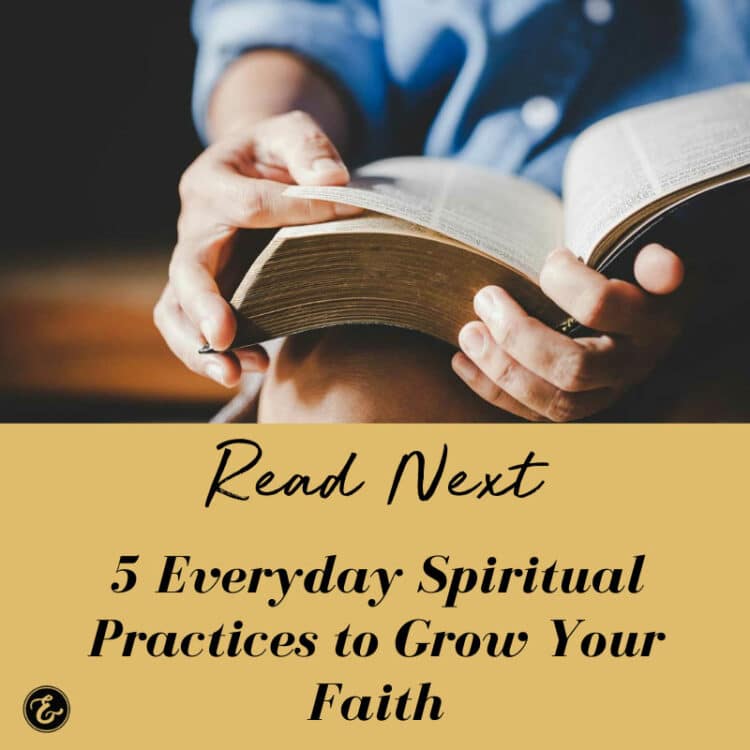Hectic Schedule? How to Create a Morning Routine that Feels Doable

I’ve been the young mom who trades multitasking in the office for barely fitting in a shower and clearing the dishwater all before the end of my husband’s work day. The mom trying all The Happiest Baby on the Block tips, like the baby-straddles-your-forearm-while-you-gently-jiggle-her-head trick to make her sleepy. My arm would fall asleep before my baby did, and when I’d lay her in her crib, slowly inch my arm free, and tiptoe out of the room, it would be mere minutes before she’d start to cry. No joke, my firstborn never napped.
Also true is that I lost a piece of me in those years of just making it through the day. Being a new mom was all-consuming, so I stopped trying to think beyond the right-now. Everything that used to give me life—like writing, reading, creating, deep conversations, and daily time with God—got put on a shelf. I wasn’t sad, but I was numb. The “half-sleep” often used to describe Enneagram 9s couldn’t be a more apt description.
Before I tell you about the good and the doable of a morning routine, you should know that I’ve also been highly resistant to routine for most of my life. I’d dismiss the idea of a morning routine, a God-time routine, a bed-time routine because it felt restrictive. I got up every morning and went to bed at night all but a handful of times in my life, and spent time with God almost every day. But it always looked different and I preferred it that way. (And I got my fix of pulling multiple all-nighters in a row before I had my first kid. Honestly, maybe those times prepared me for parenting!)
Half-Awake and No Longer OK With It
But there comes a point when you realize what you’re doing isn’t working. That you’re half-living, and you’re not okay with it. For me, it wasn’t a sudden revelation, but rather, one that unfolded slowly, as is the way with many lessons worth learning.

The fire had gone dim, but not completely out. I needed to restock the “woodstove” of my heart, as I’d once learned on a mission trip.
At first, it looked like short stints at routine. A Good Morning Girls Bible study. Then a Beth Moore one through my church. They re-whet my hunger to reconnect on the regular with God, but I was still sporadic. I’d read my Bible sometimes early, sometimes late, too often not at all. I let all the little things crowd the space, distract from the most important thing.
That’s where I was when I gave an actual morning routine a try. Maybe you can relate to some piece of my story.
If the way you’re spending time with God (or not) is not working for you, please keep reading. I’m writing this for you.
Creating a Morning Routine that Feels Doable
As you build your morning routine, first brainstorm the elements that are most important to you. Depending on how your brain works, you might find it easier to begin general and move to more specific, or the other way around. I’ll explain both, but for now, turn down the but-what’s and I-can’ts. I know they’re loud.
General-to-Specific
To give the general-to-specific method a whirl, think broad. You might list things like coffee, Bible, prayer, gratitude, worship, journaling, and reading. You choose the number of categories, but I recommend two to five, especially if you’re cramped for time.
Then, under each category, brainstorm concrete ways you could walk them out. You’re not setting anything in stone here. You’re simply listing ideas.
Under prayer, you might write things like pray Scripture, prayer walk, breath prayers, recite a prayer, journal a prayer, pray out loud, and pray outside.
You might break down gratitude into more specific practices such as keeping a gratitude journal, telling God thank you for the new day, singing along to a worship song, memorizing a Bible verse on gratitude, or writing something you’re choosing to see as a gift somewhere you’ll see it often.
Journaling gives you freedom to choose a lined journal, a guided journal, or an unlined journal to give more space for creativity. You might answer the same prompts every day. Free-write. Bullet list. Brain dump. Write prayers—the ones you’re asking and the answered ones. Copy Bible verses. Get ridiculously honest.
There are many, many ways to approach Scripture. List everything you can think of here. Following a Bible reading plan. A YouVersion devotional. Reading on your phone. Listening while you work out. Cracking open that study Bible collecting dust. Trying a translation you’ve never read before. Comparing versions as you read. Reading a section of a chapter a day. Reading a full chapter. Reading chronologically. Cover to cover. Old and New Testament simultaneously.
Once you have your general and more specific lists, circle the ideas you find most appealing. It’s okay to let the practical side of your brain weigh the doability of your ideas.
Specific-to-General
For the specific-to-general approach, brain dump all the ideas you know of that might fit into a morning routine. Things you tried or wanted to try. What sparks your curiosity? What might feel life-giving? What would fit in the amount of time you could carve out? What’s on your shelf-for-another-season list? Write everything down. Jump around, circle back—just keep going until you run out of ideas.
Then, grab some highlighters. Begin looking for patterns. Color-code your ideas as broader categories, like the ones we talked about in the last section.
Regardless of which brainstorming method you try, the idea is to come up with potential elements of a morning routine. Take some time to narrow your ideas down to the top one in each of your categories. Keep the whole list, though, because while your morning routine offers structure, it will serve you better if it’s not rigid. Some of the practices might not fit as well as you think, and others might fit well but only for a season.
Once you have your top ideas, put them in an order. This will be the outline of your morning time. Note that the goal is having a sequence versus a set amount of time. Your morning won’t always go as planned. Sometimes you might get only a minute or two to spend on each of the practices. Built-in fluidity is important so your morning routine gives more than it takes.
My Personal Morning Routine
I first learned the idea of having a sequenced structure from Emily P. Freeman, in episode 90 of The Next Right Thing. At that point, Emily followed a PRWRP (Pray-Read-Write-Read-Pray) structure. I adapted it slightly and used it as my own morning routine for years.
I’ve made more adaptions along the way in order to respond to new seasons, changed schedules, and what God stirs in my heart. For example, reading a few pages of a spiritual growth book used to be part of my morning routine (the second R), but it works better now to read later on in the day.
Here’s my current morning routine, in bullets.
- Breath prayer (same one every morning, and before I get out of bed)
- Worship music (loud in my Beats, and often the same song on repeat)
- Time on my knees (I’m learning I know God differently on my knees, so this has become a daily rhythm)
- Bible reading (usually a small section as I slowly make my way through one book of the Bible at a time)
- Journaling (I add to my running gratitude list, write out the verse that most resonated, and often free write a prayer or fill out a section or two of Stuff I’d Only Tell God, Jennifer Dukes Lee’s guided journal*)
*About Stuff I’d Only Tell God: A Guided Journal of Courageous Honesty, Obsessive Truth-Telling, and Beautifully Ruthless Self-Discovery by Jennifer Dukes Lee: I’m a little obsessed, and I think you will be too. It’s fun and deep—and most definitely unique. Written for both journalers and non-journalers, this guided journal also doubles as a conversation-starter, friendship-deepener, and marriage-strengthener. Highly recommend!
Put It Into Practice
The thing about a morning routine is unless you discover that you no longer want to live without it, you’ll look for every excuse to not stick with it. That means you have to actually give it a try—and some time. You’ll also need a hands-open mentality that gives you grace to be human and pick it up again tomorrow. Make adjustments as needed. Squeeze it into five minutes if that’s all you’ve got.
Friend, you’ve got this. Because it’s not worth half-living your life. Because you + God affects everything else. Because you get to choose what will shape the rest of your day.
—
For more on growing your relationship with God, listen to this podcast episode for practical tips: If You Want to Grow in Faith, Try These Simple Things – 144

